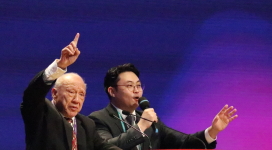
The quirky dual-screen YotaPhone is back, and this second generation device from Russia is surprising early adopters by putting the fun in functionality.
The YotaPhone 2 has many of the same features as the original YotaPhone, but with some finely tuned specs that make it more of a contender in the competitive smartphone market.
The phone's most exciting feature is its two screens: a 5-inch 1080p AMOLED touchscreen in the front and a monochromatic 4.7-inch e-paper display with 960x540 pixel resolution in the rear. While the front display holds up on its own with a resolution that rivals the smaller iPhones, it's the rear e-paper display that has everyone talking.
Reminiscent of the original Amazon Paperwhite Kindle, this rear screen allows you to preserve battery life while still doing most of what you'd do already like read news or emails.
"When reading emails, news, Twitter messages and Facebook posts you don't really need 16 million colors, making the paper display useful for more than just reading books," PC World's Mikael Ricknäs says in his review.
But some are so excited about the functionality of the YotaPhone 2 that they're calling it the most interesting smartphone they've ever used. "I've spent a fair amount of time with the device, and have to say that it's the most interesting smartphone I've ever used," declares Engadget's Jamie Rigg. "Like its predecessor, the YotaPhone 2 is still very much a niche proposition with narrow mainstream appeal. That being said, Yota Devices has more or less achieved what it set out to do last year: Make a handset with an E Ink display that has several, legitimate use cases. Whether these will actually tempt you into picking one up is another matter, but the second screen is no longer an oddity; it's an asset."
The YotaPhone 2 runs Android 4.4.3 Kitkat as its stock operating system with a Lollipop upgrade planned in the near future. And what's really interesting is the fact that you can even run Android on the back e-paper screen as well. "It's worth noting, though," Engadget points out, "that while the E Ink display's touchscreen responsiveness is fantastic, meaning you can use Android at full speed, anything that requires a high refresh rate -- a video, let's say -- actually drains the battery quicker on the E Ink side than it would if running on the AMOLED panel."
A 2.2GHz Snapdragon 800 processor lies under the hood, which is the same chip powering the Sony Xperia Z Ultra. Combine that with the 2 GB of RAM and 32 GB of storage and you have a device that's right on par with most other high-end devices from major manufacturers.
But the one point that stuck with most reviewers as a negative about the YotaPhone 2 is its price. At £555 (about $870 US), you're mostly paying for that dual-screen feature, but that's to be expected. The YotaPhone 2 will be available in most of Europe and the Middle East on December 15, with a ship date to Hong Kong by the end of the month and China by early next year. It is expected to go on sale in the U.S., Canada, and Latin America soon afterwards.







![[Exclusive Interview] Evangelist Stephen Tong exhorts the Chinese church to return to the foundations of reformed faith](https://www.gospelherald.com/media/cache/thumbnail/7/23/72340sp_273w_150h_1x_1y.png)